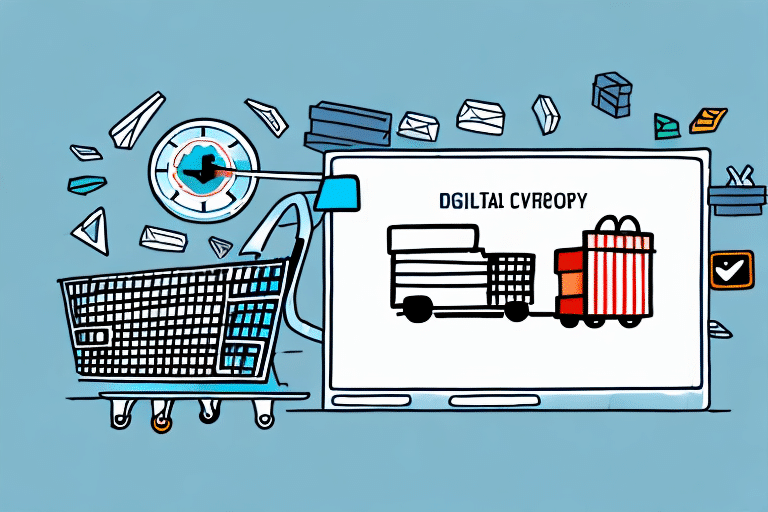Measuring Purchase Order Cycle Time and Its Impact on E-Commerce Operations
In the fast-paced world of e-commerce, timing is everything. A seemingly small delay in the purchase order cycle time can have a significant impact on the overall efficiency and profitability of a business. According to a McKinsey & Company report, optimizing purchase order processes can lead to a 20-30% improvement in operational efficiency. This is why measuring purchase order cycle time is crucial for e-commerce operations. This article explores the importance of measuring purchase order cycle time, the components of the purchase order cycle, factors that affect cycle time, and strategies to optimize purchase order cycle time in e-commerce businesses.
Why Measuring Purchase Order Cycle Time Matters for E-Commerce Businesses
Purchase order cycle time measures the duration it takes for an e-commerce business to process purchase orders, from the initial request to receiving the product. This metric is essential for several reasons:
- Operational Efficiency: Measuring cycle time provides data that helps businesses identify inefficiencies and implement strategies to streamline operations, potentially reducing costs and increasing profitability.
- Goal Setting and Benchmarking: Understanding cycle time allows businesses to set realistic targets and monitor progress, fostering continuous improvement.
- Customer Satisfaction: Faster processing times lead to quicker deliveries, enhancing the overall customer experience and fostering loyalty.
- Inventory Management: Analyzing cycle time helps identify trends in purchasing behavior, enabling better inventory forecasting and management.
Effective measurement of purchase order cycle time can lead to significant improvements in both operational performance and customer satisfaction.
Understanding the Components of the Purchase Order Cycle
The purchase order cycle consists of several critical components:
- Supplier Identification: Selecting reliable suppliers who can deliver goods or services on time.
- Order Placement: Initiating the purchase order with detailed specifications.
- Order Confirmation: Receiving acknowledgment and confirmation from the supplier.
- Order Processing: Verifying order details such as quantity, price, and delivery dates.
- Shipping and Delivery: Ensuring timely dispatch and receipt of goods.
- Invoicing and Payment: Managing billing and processing payments efficiently.
Each component plays a vital role in ensuring a smooth and efficient purchase order cycle. Delays or errors in any of these stages can significantly impact the overall cycle time.
Factors That Affect Purchase Order Cycle Time in E-Commerce
Several factors can influence the purchase order cycle time in e-commerce:
- Order Complexity: More complex orders with multiple items or customization can take longer to process.
- Data Accuracy: Inaccurate or incomplete order data can lead to delays and errors.
- Product Availability: Stock shortages or backorders can extend the cycle time.
- System Efficiency: Inefficient order processing systems can cause bottlenecks.
- Shipping Speed: Delays in shipping and delivery services affect the overall cycle time.
- Invoicing and Payment Processes: Complex or slow payment procedures can prolong the cycle.
- Communication: Poor communication between buyers and sellers can result in misunderstandings and delays.
- Level of Automation: Lack of automation in order processing can increase cycle time due to manual interventions.
Addressing these factors is essential for optimizing purchase order cycle time and enhancing overall business operations.
The Importance of Streamlining Purchase Order Processes
Streamlining purchase order processes is critical for e-commerce businesses aiming to reduce cycle time and improve efficiency. Key strategies include:
- Automation and Technology: Implementing automated systems can minimize manual data entry, reduce errors, and speed up order processing. For instance, Forrester’s evaluation highlights the benefits of advanced purchase order management software in enhancing operational efficiency.
- Centralized Purchasing Systems: Consolidating purchasing activities through a centralized system can simplify procurement, negotiate better terms with suppliers, and reduce the number of vendors.
- Inventory Management: Efficient purchasing processes enable better inventory control, reducing the risks of stockouts and overstocking, which in turn lowers costs and improves cash flow.
By implementing these strategies, businesses can achieve more streamlined operations, leading to reduced cycle times and enhanced customer satisfaction.
Tools and Technologies to Measure and Analyze Purchase Order Cycle Time
Several tools and technologies can assist e-commerce businesses in measuring and analyzing purchase order cycle time:
- Purchase Order Management Software: These platforms enable businesses to track and manage the entire purchase order process, providing real-time updates and identifying bottlenecks.
- Data Analytics Tools: Tools like Tableau and Microsoft Power BI allow businesses to analyze order data, identify trends, and make data-driven decisions.
- Business Intelligence Software: Solutions such as SAS Business Intelligence provide comprehensive insights into purchase order processes.
- Workflow Automation Tools: Tools like Zoho help automate repetitive tasks, reducing cycle time and minimizing errors.
Utilizing these tools allows businesses to gain detailed insights into their purchase order processes, identify areas for improvement, and implement effective strategies to enhance efficiency.
Case Studies: How E-Commerce Companies Improved Their Purchase Order Cycle Time
Several e-commerce companies have successfully optimized their purchase order cycle time through strategic planning and technology implementation:
- Automated Workflow Systems: One company implemented an automated workflow system, resulting in a 50% reduction in cycle time. This automation streamlined order processing and reduced manual intervention.
- Purchase Order Management Systems: Another business improved order accuracy by 90% by adopting a comprehensive purchase order management system, leading to faster and more reliable order fulfillment.
- Optimized Supply Chain Processes: By refining inventory management and strengthening supplier relationships, a company achieved a 40% reduction in cycle time.
- Vendor-Managed Inventory: Implementing a vendor-managed inventory system allowed a business to better track and manage inventory levels, resulting in a 60% decrease in cycle time.
These case studies demonstrate that strategic use of technology and process optimization can lead to significant improvements in purchase order cycle time, benefiting both the business and its customers.
Strategies to Optimize Purchase Order Cycle Time and Improve E-Commerce Operations
To optimize purchase order cycle time, e-commerce businesses can adopt the following strategies:
- Process Automation: Utilize automation tools to handle repetitive tasks, reducing manual errors and speeding up order processing.
- Implement Purchase Order Management Systems: Adopt integrated systems that provide end-to-end visibility and control over the purchase order process.
- Set Clear Goals and Expectations: Establish measurable targets for cycle time and regularly monitor progress to ensure continuous improvement.
- Data Monitoring and Analysis: Regularly analyze purchase order data to identify trends, patterns, and areas for enhancement.
- Supplier Relationship Management: Foster strong relationships with suppliers to ensure timely deliveries and resolve issues promptly.
- Employee Training and Development: Invest in training programs to equip employees with the necessary skills to manage purchase orders effectively.
Implementing these strategies can lead to more efficient purchase order processes, reduced cycle times, and improved overall business performance.
Best Practices for Managing Purchase Orders in E-Commerce Businesses
Managing purchase orders effectively requires adherence to best practices that ensure accuracy and efficiency:
- Standardized Processes: Develop and follow a standardized procedure for processing orders to maintain consistency and reduce errors.
- Clear Supplier Expectations: Communicate clear expectations regarding order processing times, quality standards, and delivery schedules with suppliers.
- Accurate Inventory Management: Maintain up-to-date inventory records to prevent stockouts and overstocking, ensuring that orders can be fulfilled promptly.
- Regular Monitoring: Continuously monitor purchase order cycle time metrics to identify and address any inefficiencies.
- Effective Communication Channels: Establish reliable communication channels with suppliers to facilitate quick resolution of issues and ensure smooth order processing.
- Secure Payment Systems: Implement secure and efficient payment systems to ensure timely and accurate processing of invoices and payments.
Adhering to these best practices helps e-commerce businesses manage their purchase orders more effectively, leading to improved operational efficiency and customer satisfaction.
Future Trends in Measuring and Improving Purchase Order Cycle Time in E-Commerce
The future of measuring and improving purchase order cycle time in e-commerce is set to be shaped by advanced technologies and evolving business practices:
- Artificial Intelligence (AI): AI can automate repetitive tasks, such as data entry and order processing, significantly reducing cycle time and enhancing accuracy. AI-powered predictive analytics can also forecast demand, enabling better inventory management.
- Blockchain Technology: Blockchain can enhance supply chain transparency and security by providing a tamper-proof record of all transactions. This can reduce fraud, minimize errors, and accelerate transaction speeds.
- Internet of Things (IoT): IoT devices can provide real-time tracking of shipments and inventory levels, facilitating faster decision-making and improving the responsiveness of the purchase order process.
- Advanced Data Analytics: Leveraging big data and advanced analytics can provide deeper insights into purchase order trends, enabling more effective optimization strategies.
- Integration of Systems: Seamless integration of purchase order systems with other business platforms (e.g., ERP, CRM) will enable more efficient data flow and process management.
As e-commerce continues to evolve, businesses that adopt these emerging technologies and trends will be better positioned to optimize their purchase order cycle time, maintain competitiveness, and meet the growing expectations of their customers.
Conclusion
Measuring purchase order cycle time is critical for e-commerce businesses aiming to enhance operational efficiency, reduce costs, and improve customer satisfaction. By understanding the components of the purchase order cycle, identifying factors that affect cycle time, and implementing effective strategies and technologies, businesses can significantly optimize their purchase order processes. Embracing future trends such as AI, blockchain, and advanced analytics will further empower e-commerce companies to maintain a competitive edge in the rapidly evolving digital marketplace.






















